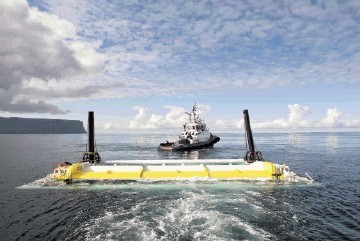
A new system for measuring waves and currents could be “transformational” for Scottish marine-energy developments, the research team behind it said yesterday.
Senior research engineer Arne Vogler at Lews Castle College UHI, part of the University of the Highlands and Islands, added it could also deliver major benefits for offshore windfarms, harbour management and the oil and gas industry.
Traditional wave and current measurement methods rely on floating buoys.
Mr Vogler and his team, working as part of the three-year, EU-funded Merika (marine energy research innovation and knowledge accelerator) programme, recently completed a year-long trial of their innovative maritime radar system.
It can accurately measure the height and frequency of waves or the behaviour of currents over a radius of up to three miles, Mr Vogler said, adding the buoy method gave much more limited results.
Knowing the strength and distribution of the potential energy resource is crucial for wave and tidal-power projects, he said.
He added: “This method gives us real-time information to assess what’s going to happen in a few minutes’ time.”
Hotspots of potential energy creation spread over an area can make all the difference for choosing the right location for a wave-energy converter or tidal-energy device, he said, adding: “It’s important to understand where these are.”
Mr Vogler said the data could also be invaluable for harbour management, where sudden changes in the waves and tides dictate whether ships can come in and out.
The new system employs a standard marine radar, used by ships to detect obstacles, which has been modified to maximise the data it picks up from the surface of the sea.
“It is easier to maintain as it’s onshore,” Mr Vogler said, adding: “This system could be transformational for many offshore based industries and commercial interest, even at this early stage, is high.”
Research team member James Morrison said: “The standard method of measuring waves uses small, single point buoys, however, these systems can be expensive to install and recover, and are very vulnerable to damage, loss and theft.
“The new technique can be used to accurately monitor large areas of sea, at low cost, with little supervision and maintenance.”
Mr Vogler and his team are currently analysing data from the trial and exploring options to commercialise the system.
They have also contributed to trials of a similar system at the European Marine Energy Centre in Orkney, alongside colleagues from North Highland College UHI’s Environmental Research Institute.
Merika is a UHI initiative aimed at turning the university’s Faculty of Science, Health and Engineering into a European centre of excellence for marine-energy focused research and innovation.
Recommended for you
